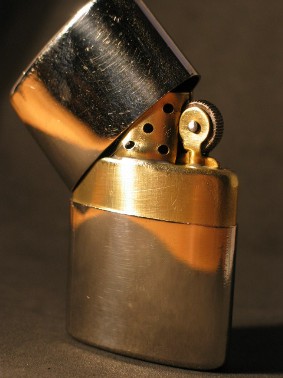
History of the Zippo lighter!
Zippo was founded in
Bradford, Pennsylvania in 1932 by George G. Blaisdell. He was born on June 5,
1895, in Bradford. On the surface of it, young George Blaisdell hardly seemed
like someone who would find success in the brutal years of the Depression. He
had very little formal education. He hated school; walked out of fifth grade and
told his family he wasnt going back.
His father bundled him off to a military academy, but young George Blaisdell
lasted only two years there before he was summarily dismissed. His father put
him to work in the family business the Blaisdell Machinery Company where he
learned metal work, a skill that would come in handy in the germination stages
of the Zippo lighter nearly thirty years later.
After World War I, he took over the family business, then sold the machinery
company in 1920 and put the money in oil. The 20s roared then stopped. Oil
plunged along with just about everything else into the Great Depression.
The Zippo's story begins at this darkest moment. Zippo's success came about
through initiative and hard work, through the creation of a durable and
functional product, through ingenious marketing and attentive service, and
through the innovation of a lifetime product warranty. It all started on one
summer evening in 1932, at a dinner dance held at the Bradford Country Club, on
a hill on the outskirts of Bradford, Pennsylvania. Attending the dance was
George G. Blaisdell, who later became known as "Mr. Zippo." Blaisdell was one of
those looking for a new way to make money.
So far, he had yet to bump into anything promising. Blaisdell, who had been growing tired of the dance and idle talk of politics, went out onto the terrace to have a smoke. There, he saw a friend of his trying to light up a cigarette, taking out of his pocket an unsightly brass lighter that was patently tawdry. The ugly lighter was totally out of place in the hand of the perfectly attired gentleman. The sight of the man trying clumsily to open the lighter's lid was so comical that Blaisdell almost started to laugh. "You're all dressed up. Why don't you get a lighter that looks decent?" blurted Blaisdell. His friend must have thought it was none of Blaisdell business. "It works!" he declared, defensively. Those two words, "It works!", whirled in George Blaisdell's head that night.

Picture of the old
lighter that has inspired Mr.Blaisdell
THX to ZippoFritz for the picture.
In these times, everyone must be looking for something that is low-priced, yet sturdy and durable, he thought. No, that isn't so; those things are always sought after, not just in bad times. This lighter business is promising!Blaisdell immediately obtained the sole U.S. rights from the Austrian lighter manufacturer. To improve its appearance, Blaisdell chrome-plated the lid of the lighter and raised the price to one dollar. He couldn't sell any, he discovered that there were defects in the lighter. Blaisdell was determined to develop a new lighter that would not fail to light. Abandoning the defective Austrian lighter, Blaisdell rented a corner of the second floor of the Rickerson & Pryde, Inc. building on Boylston Street. Blaisdell paid $10 a month in rent, hired three people, and began to develop a new lighter. He and his team used an electric hot plate for soldering. Everything from the punch press to the welder was second-hand equipment. The total cost of his equipment was $260 at the time. The first thing Blaisdell did was to make the lighter smaller to be able to fit in the palm of the hand, and he incorporated a hinge to hold the lid to the bottom, making it an integral part of the lighter. This enabled the user to open the lighter using only one hand. Blaisdell then placed a wind hood around the wick, he utilized the hood design of the Austrian lighter and named the new product "Zippo".
The original Zippo model was introduced in early 1933. This model had a rectangular shape with a protruding hinge holding the lid to the body and three barrels. The following year, the model was shortened by 1/4 inch. The retail price of the original windproof model was $1.95. In the company's ledger at the end of the first month, 82 units. At the next month he sold 367 pieces. To market the new product, Blaisdell came up with the practice of a lifetime warranty, a concept that began with the first Zippo lighter and has remained the same to the present day. The repair and sale of parts after the expiration of the warranty was a major source of the business revenue.
![]()